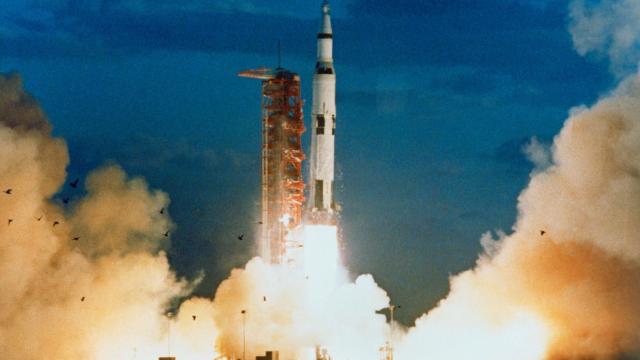On November 9, 1967, a 110.64 m-tall Saturn V rocket launched from NASA’s Kennedy Space Centre, generating 7.5 million pounds of thrust. The blast created by the Apollo 4 liftoff was among the loudest noises ever produced by our species, scientists calculated at the time. In fact, the roar was so loud that it sparked a rumour that the Saturn V launch melted concrete and lit grass on fire over a mile away.
A team of scientists is now claiming to have put this rumour to rest, suggesting that, while the Saturn V rocket launch was very, very loud, it was not loud enough to melt concrete. As NASA prepares to send the even-more powerful Space Launch System (SLS) on the Artemis 1 mission to the Moon and back, the agency will use water in an attempt to partially dampen the rocket’s blast, which is predicted to be even louder than Saturn V.
When the Saturn V launched, not a lot of data was available to precisely calculate the amount of noise. To estimate the acoustic levels of a Saturn V launch, the scientists behind the recent study created a physics-based model that churned out a value of 203 decibels. “Decibels are logarithmic, so every 10 decibels is an order of magnitude increase,” Kent Gee, a researcher at Brigham Young University and lead author of the study published in The Journal of the Acoustical Society of America, said in a statement. “One hundred and seventy decibels would be equivalent to 10 aircraft engines. Two hundred would be 10,000 engines!” As an aside, the human threshold for pain starts at around 130 decibels.
So it’s no wonder the launch inspired the highly exaggerated myth, but the study confirms that the noise generated by Saturn V’s liftoff is not enough to burn distant grass, let alone melt concrete. The study claims that the myth likely started due to confusion between sound power and sound pressure, with one being akin to wattage coming from a light bulb and the second being like the brightness emitted from that same light bulb, according to the researchers. Therefore, it’s likely that prior attempts to calculate the acoustic power of the Saturn V launch were incorrect, leading to the misconception. “The Saturn V has taken on this sort of legendary, apocryphal status,” said Gee.
At the time, Saturn V was the most powerful rocket built by NASA and it was used to launch Apollo missions to the Moon. But now it’s time for NASA’s SLS rocket, which is currently sitting atop launchpad 39B (Saturn V took off from 39A) ahead of the Artemis 1 launch scheduled for August 29. This time, however, NASA is prepared for all the ruckus generated by the launch of a megarocket. The space agency has developed a sound suppression system that will release 450,000 gallons (2 million litres) of water onto the mobile launcher platform immediately before the rocket fires its main engine. The water will flow to special outlets on the platform by way of gravity, reducing the acoustic levels to about 142 decibels.
The researchers behind the new study plan to use the same framework used in the Saturn V analysis to predict the sounds coming from SLS, and also measure the acoustic levels during the actual launch to help refine their predictions in the future.
